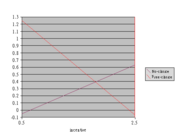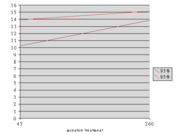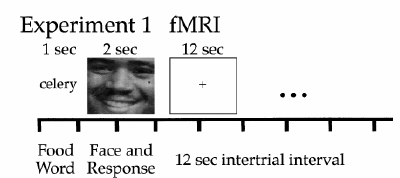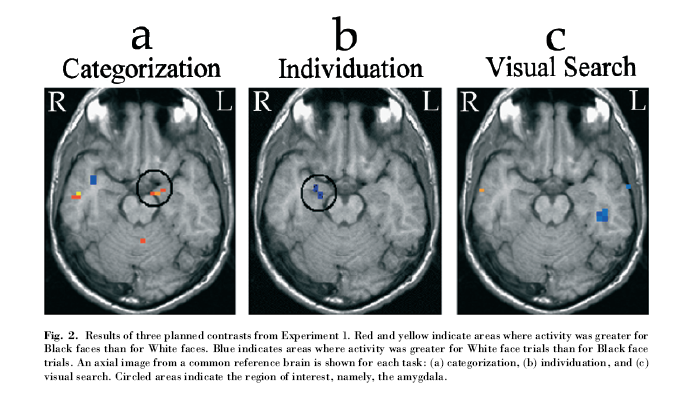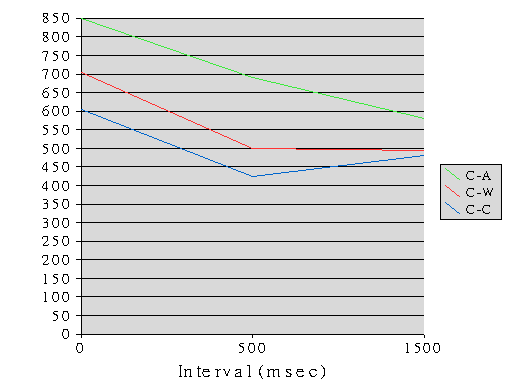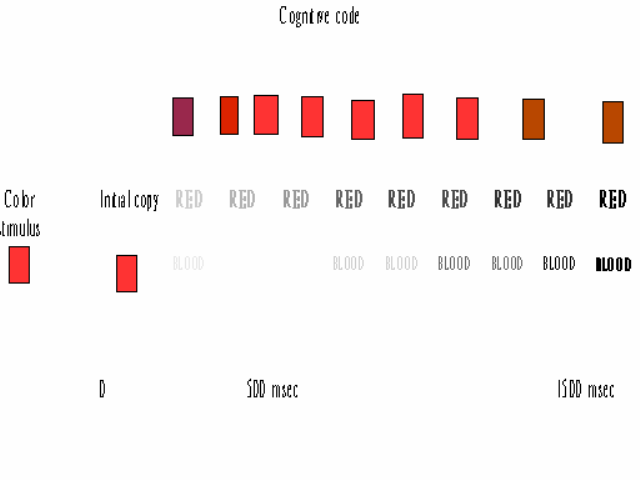心理實驗法第六講:Basic of control
出自KMU Wiki
Basic of Control and Factorial Design
心理實驗法九十六學年度第五講
前面幾張省略(因為與上一講重復)
目錄 |
Placebo
- Case Study (p.48)
- Paul (1966) speech phobia的治療
- 分四組(共67人)
- 接受behavior therapy(15人)
- 接受insight therapy(15人)
- 吃無害也無效的藥丸(15人)
- 未接受任何治療(control 22人)
- DV
- 四位clinical psychologist(不知情)之前後測差異
- 結果
- Behavior 進步 100%
- Insight 進步 60%
- Pills 進步 73%
- Control 進步 32%
- 第三組稱為
- Placebo control group
- 所吃的藥稱為
- Placebo pills
- 所呈現的效果為
- Placebo effects
- Experimenter Bias
- 前面的實驗
- 如果打分者知道所評分對象接受了什麼治療...
- Scorer's bias
- 韓國裁判?
- 如何避免?
- 前面的實驗
- Blind control
- Single blind
- Double blind
- Case Study (p.50)
- Rosenthal and Fode (1963)
- 告知學生
- 一組老鼠為maze-bright
- 另一組老鼠為maze-dull
- 結果
- Maze-bright的老鼠表現遠較maze-dull為佳
- 其實兩組老鼠由同一種老鼠中隨機抽取
- 告知學生
Within-subject
- Between-subject design 受試者間設計
- Group A Experimental conditon Measure
- Group B Control condition Measure
- Within-subject design 受試者內設計
- Subject A->experimental condition1 + experimental condition2 +......
Within的好處
- 減少subject數量
- 可以不必考慮實驗組與控制組之環境是否相同
- 較易顯著(統計上)
Why易顯著
由SS(sum of square)看
- SSt=SSb+SSw (between subject)
其中SSt代表Sum of Square total,是整體的變異大小。SSb代表Sum of Square between groups,也就是組間的變異大小。SSw代表Sum of Square within groups,是組內的變異大小。統計顯著性考驗時,則先各求MSb(Mean Square between groups)與MSw(Mean Square within groups)再求其比值(就是F值)。
- SSt=SSb.sub+SSw.sub=SSb.sub+SStreatment+SSresidual (within subject)
其中SSt與上面同。SSb.sub代表Sum of Square between subjects,是受試者間的變異大小。SSw.sub代表Sum of Square within subjects,是受試者內的變異大小。同時SSw.sub可以再分為SStreatment(Sum of Square between treatment)與SSresidual(Sum of Square residual)兩個部分。SStreatment代表各操弄間的變異,SSresidual代表剩餘的變異。在統計顯著性考驗時則求MStreadtment(Mean Square between treatments)與MSresidual(Mean Square residual)再求其比值。
因為在within subject時從SSt去除了SSb.sub,所以剩下的變異一定比較小。可能有利於F值的表現。為何有利,可能還需要看個別資料來說明。
由個別來看
- xij=μ+βj+εij (between subject)
其中i代表在組內不同受試者,j代表不同的組別。x是所測得的資料,μ代表整體平均數,βj代表各組的效果,εij代表各測量的誤差。本式代表每一個測量(xij)得自整體平均數(μ)與所給予的操弄的效果(βj)與每一次測量的誤差(εij)的和。
- xij=μ+βj+πi+εij (within subject)
基本上符號與上面相同,只是多了πi為個別差異(individual difference)。每一個測量(xij)當中,誤差中(εij)看出效果(βj)大小的比值時within subject就可以扣除個別差異,自然可以較易顯現效果。
本段主要參考:林清山(1992)心理與教育統計學。台北:東華書局。
不能用within的時機
- 以下時不可用(較不適用)within-subject design
- 對受試者影響具持續性
- 呈現的次序會影響結果時
- 有以上嫌疑時
PC與Psychology
- 實驗控制上常用PC (personal computer)
- 快速呈現
- 隨機排列
- 收集資料
- .....
心理學實驗中另一項問題
- Demand characteristics
- 受試者會揣測主試者的意圖,而試著去符合或不符合主試者的要求,造成反應偏誤,不該顯著的結果卻顯著。
- 情境
- 防音暗室
- 一堆怪機器(自己拉的線、用角鋼....)
- 面貌凶惡的男主試
- 大一修普心嫩嫩的受試
- 主試問:「有沒有看到!」
Two meanings of control
- Control of IV
- Spallazani實驗中精液的不同
- 人工環境中金絲雀築巢
- Control environment
- 實驗組與控制組間的差異除了上面控制以外控制成相當
Factorial design
- 隨著時代進步,心理學的方法也進步
- 但心理學想問的問題本質沒有變
- 探討人類心理與行為背後存在的...
- 以前所有問題都只能問最簡單的地方
- 現在有能力問更多
- 為什麼要問更多?
實驗的目的
- Cause-and-effect relationships
- Deprivation -> hungry
- Conflict -> anxiety
- 但人的行為/心理現象通常不是只有一個原因造成
- 高速公路標示辨識為例
- 什麼因素會影響高速公路標示辨識?
- 光線
- 認字能力(韓文標誌看得懂嗎?)
- 意識狀態(如24小時未睡)
- 吃藥或喝酒
- ......
- 不只
- 一個原因影響
- 高速公路標示辨識為例
多因子設計
- 多因子設計(factorial design)
- 研究者在一個實驗裡同時觀察兩個或兩個以上的自變項對一個依變項影響的設計
- 例如
- 父母育兒具敵意且過度干涉 -> 小孩退縮
- 若再加上忽略小孩 -> 小孩反社會
- 有些問題勢必兩項或以上的因素在
- 一起才會發生
Chapter 4 Case study 1
Ehrenfreund and Badia (1962)
- 目的:老鼠在不同剝奪量和獎賞量下表現
- Factor 1 剝奪量
- 95% / 85% ad lib (free-feeding) weight
- Factor 2 獎賞量
- 45mg / 260mg food pellet
- Factor 1 剝奪量
- Dependent variable
- 6 feet跑道中間2 feet的速度
- 控制
- Ad lib weight
- 自然狀態下的體重
-
- 因為每一隻老鼠的體重進食量不一,因此控制剝奪量本身對於個
- 別動物的影響不同
- 量中間段的速度
- 因為起跑段與終點段的變化比較大
- Ad lib weight
- 結果
- p.55 table 4.1
- p.55 table 4.1
| Incentive treatment | Deprivation treatment | |
| 95% | 85% | |
| 45mg | ||
| 260mg | ||
- Factors, variables and levels
- Case study 1 為 2X2之factorial design
- Factor 1 為剝奪量
- 有2 levels 之variables
- 即high and low deprivation
- Factor 2 為獎賞量
- 亦有2 levels 之 variable
- 即high and low incentive
- 最多有幾個factor?
- 平常的用語,Factors有時說成variables但一般不會反過來
- Factors與variables組合
- High deprivation – high incentive
- High deprivation – low incentive
- Low deprivation – high incentive
- Low deprivation – low incentive
- 2X2 = 4種組合
- 如果2X2X3 = 12種組合
Measuring attitude
- 態度的測量
- 問卷調查
- 你贊成增加給窮人的社會褔利支出嗎?->19%
- 你贊成增加給窮人的社會救助支出嗎?->63%
- 問卷調查中抽樣的三個層次
- 實體抽樣
- 問題之抽樣
- 受訪者回答之抽樣
- 問卷調查
2Cognitive dissonance theory (Festinger,1957)
- Attitude change occur in high-dissonance condition
- Linder, Cooper, and Jones(1967)
- 2X2 factorial design
- Task 寫一篇支持控制言論自由的文章(原本為反對的人)
- Factor 1 選擇(有無告知受試者可不可以有選擇)
- Factor 2 獎賞 $.5 / $2.5
- 結果2
- p.57 table 4.2
| Choice | Incentive | |
| $.5 | $2.5 | |
| No-choice | -0.05 | 0.63 |
| Free-choice | 1.25 | -0.07 |
- 繪圖
- p.57 figure4.1
- Analysis of variance
Statistically significant
- 'αlevel'
- .05代表20次有一次by chance顯著
- 'p value'
- 犯type I error 的機率
- 作圖的重要性
- Case study 1之圖
3 Subject variables
- Chi(1978)
- A variables -> recall digits / chess pieces
- B variables -> children / adults
- 結果 p.60 figure 4.3
- Interaction!!
4 Wheeler & Fiske (2005) 2 X 3
- p. 61 下面的圖
- A variable : race of face
- Black/ white
- B variable : social goals
- Categorization(判斷年齡)/ Individuation(食物喜好)/ Visual search(有無痣)
- 呈現方式
- 結果測量 fMRI 測amygdala
5 code and cognitive process
- “code” record in memory (Posner等人)
- Solso and Short (1979)
- 步驟
- 呈現「色板」
- 間隔後出現第二刺激
- 受試者以按鍵反應「合不合」
- 記錄受試者反應時間(reaction time)
- Complex factorial design
- Factor 1 (type of relationship)
- Color to associate / color to word / color to color
- Factor 2 ( delay between stimulus)
- 0msec. / 500msec. / 1500msec.
- Factor 3 (match or mismatch)
- 3 X 3 X 2
- Case study 5 figure
- Figure 4.5
Mental chronometry
- 實驗結果如p.63 figure 4.5
- Solso and Short的解釋如p.64 figure 4.6
-
- 由reaction time 推測內在歷程
- 利用tachistoscope (T-scope)
- Forced-choice procedure
- Within subject
- Model for case study 5
- Figure 4.6
-
